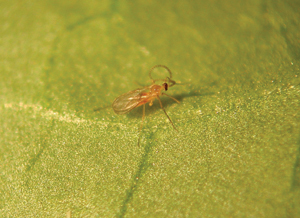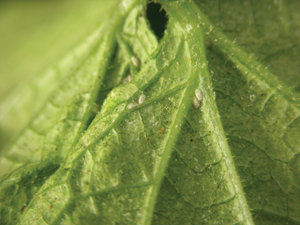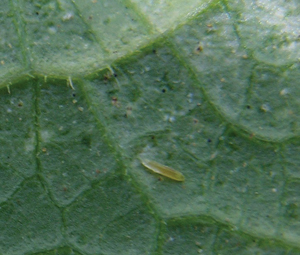
Features
Biocontrols
Inputs
Greenhouse growers notes: A promising new predator
November 18, 2008 By Gillian Ferguson Tom MacDonald and Sheila Goodfellow
The gall midge, Feltiella acarisuga, is a mosquito-like insect
that can greatly assist in biological control of two-spotted spider
mites (TSSM) in greenhouse vegetables.
Research is showing that gall midge can help with biocontrol of spider mites in vegetable crops
 |
| Adult Feltiella acarisuga resting on leaf surface Photo provided with the kind courtesy of Biobest Canada |
The gall midge, Feltiella acarisuga, is a mosquito-like insect that can greatly assist in biological control of two-spotted spider mites (TSSM) in greenhouse vegetables.
This past summer, F. acarisuga was released as part of a large commercial trial at Cristofari Farms in Leamington, Ont. This predator was included because of its ability to fly and its highly effective searching abilities. This is in contrast to commonly used predatory mites, which can only walk on the plant’s surface to locate their prey. In addition, the predation capacity of F. acarisuga is reported to be much higher than that of Phytoseiulus persimilis. The objective of releasing this predator was to observe how F. acarisuga might contribute to an IPM program that has traditionally been based upon the use of various predatory mites. Weekly observations produced very encouraging results.
Feltiella acarisuga is widely distributed naturally and is thought to prey specifically on tetranychid mites, the family to which TSSM belongs. Once adult F. acarisuga are released in a crop, they fly around searching for spider mites. When they’ve located a spider mite colony, they lay eggs on the leaves alongside the spider mite colonies. After about two days, orange-coloured larvae, the predatory stage, hatch and can begin feeding immediately.
While some studies indicate that a female F. acarisuga can lay as many as 24 to 33 eggs in her lifetime, other studies indicate this to be as low as 10 per female, depending on available food. A food source such as honeydew or a sugar solution is needed for F. acarisuga to maximize its egg-laying capacity.
 |
| White cocoons or pupae of Feltiella acarisuga alongside veins of cucumber leaf. Photo courtesy Gillian Ferguson, OMAFRA |
Feltiella acarisuga has three larval stages and they feed on all stages of mites. Larvae feed by sucking the eggs of TSSM, either partially or entirely, killing the egg in either case. Larval F. acarisuga will also attack adult TSSM by first paralyzing them. Research at Texas A&M University System indicates that larvae can consume an average of 185 eggs during their lifetime. If, however, larval F. acarisuga are unable to find TSSM, they will become cannibalistic and feed on their own eggs, larvae and pupae. After about a week when the larvae have matured, they transform into pupae that appear as small white cocoons that are usually found alongside leaf veins. After another week or so, depending on temperature, adults emerge, mate within 24 hours, and begin laying eggs after one or two days.
Work by Agriculture and Agri-Food Canada’s Dave Gillespie and Don Quiring indicate that overall development time ranges from more than 30 days at 15°C to less than 10 days at 27°C. Temperatures above 30°C are lethal to the larvae. Generally, higher humidities favour the performance, reproduction and survival of this predator.
Studies, also by Gillespie and Quiring, showed that predation by F. acarisuga increases exponentially between 40 and 90 per cent RH. They also observed that larvae stopped moving when they were exposed to 30-50 per cent RH.
Temperature and humidity conditions during July of this past year appeared to favour activity of F. acarisuga in commercial cucumbers at Cristofari Farms. Only one release was made at the beginning of July, and this consisted of 1,000 F. acarisuga pupae to each of four houses, which each measured 200 ft x 37 ft (61 m x 11.3 m).
At this time, spider mite populations were increasing quickly, primarily due to the prevailing high temperature conditions. Within two weeks of release, larvae were visible in many areas of high spider mite populations, and pupae were visible one week after the larvae were observed. Where larvae were observed, there were on average two to three per leaf.

|
| Larva or predatory stage of Feltiella acarisuga feeding within spider mite colony on underside of cucumber leaf. Photo courtesy Gillian Ferguson, OMAFRA |
In one house that was more highly infested, F. acarisuga was present on 40 per cent of all the leaves sampled, and in one location, over 20 each of larvae and pupae were counted. The percentage of live spider mites on these leaves was correspondingly very low.
This experience indicates that perhaps we have not sufficiently tapped into the potential of F. acarisuga. In addition to its ease of application and mobility within a crop, work in the U.K. has shown that F. acarisuga can successfully suppress spider mites on hairy plants such as tomatoes, and also prey on carmine mites and diapausing mites.
However, environmental conditions such as low humidity and very high temperatures can limit its activity. Also, because its rate of reproduction is lower than that of TSSM, repeat releases are recommended for suppression of TSSM. Bearing in mind all of the factors that favour activity of F. acarisuga, we feel that this predator will make a valuable contribution to suppression of TSSM in greenhouse vegetables.
Acknowledgments:
■ The kind co-operation of Domenic Cristofari of Cristofari Farms, Leamington, and support of MGS Horticultural Inc. Leamington, in trials for evaluation of biological control agents against two-spotted spider mites in greenhouse cucumbers is gratefully acknowledged.
Authors: Gillian Ferguson, Ontario Ministry of Agriculture, Food & Rural Affairs, Greenhouse & Processing Crops Research Centre, Harrow, Ont.; Tom MacDonald and Sheila Goodfellow, MGS Horticultural Inc., Leamington, Ont.
Print this page